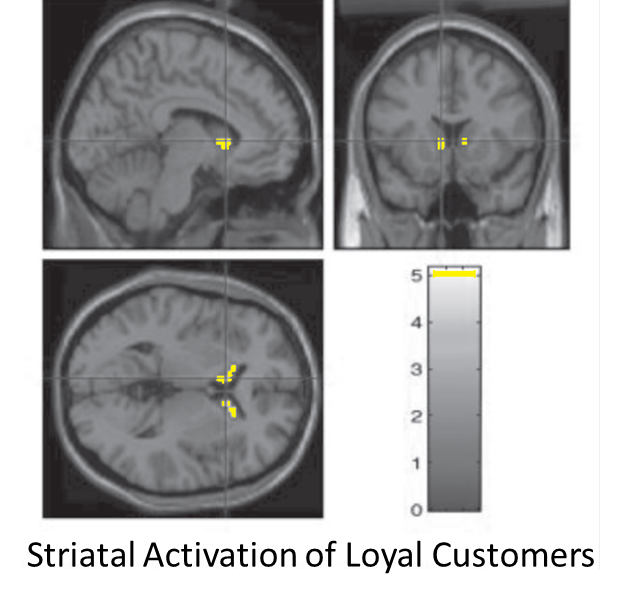Scientists have discovered a distinct neural signature in the minds of loyal customers. Scans show particular a brain region activates when buyers choose their preferred vendors. Given the importance of customer loyalty and the recurring revenue that comes with it, how can companies nudge their customers to always choose them over the competition? Science says it’s simple: by winning their hearts along the way.
Exciting neurons
 Researchers used functional magnetic imaging (fMRI) to scan the brains of consumers listed in a department store database.[1] Half the people purchased frequently at the department store, while the other half did not. With the MRI humming, neuroscientists tasked people to choose a place to shop for clothing. Certain parts of the brain lit up when loyal buyers selected their favorite store, but the same areas remained dark for the disloyal shoppers.
Researchers used functional magnetic imaging (fMRI) to scan the brains of consumers listed in a department store database.[1] Half the people purchased frequently at the department store, while the other half did not. With the MRI humming, neuroscientists tasked people to choose a place to shop for clothing. Certain parts of the brain lit up when loyal buyers selected their favorite store, but the same areas remained dark for the disloyal shoppers.
Through the experiment, the scientists had isolated the neural circuitry associated with customer loyalty. The study implicated the striatum, an area known for calculating anticipated rewards. Higher activation in this region proved loyal customers associated greater emotional benefits with their favorite providers.
The results confirmed previous findings that certain brain activity corresponded to brand preference.[2] Not only did the mind trigger the same network, but in the earlier study scientists also found rational thinking took a back seat to feelings. When people saw their favorite choice, the brain switched off conscious, logical thinking, allowing subconscious emotions to make the final decision unchecked. Choosing a favorite brand was literally a “no-brainer.”
The two studies provide a neural basis for what customer loyalty researchers call affective versus calculative commitments.[3] Affective commitment occurs when a customer wants to do business with a provider, whereas calculative commitment happens when the customer has to. Faced with the choice of buying again, loyal, affective customers automatically repurchase. But disloyal, calculative customers retreat to the spreadsheets, spending more time researching alternatives and weighing costs and benefits.[4] Neuroscience now shows the mechanisms underlying these behaviors.
Mind-altering drug
So what sways customers towards loyalty? Biochemistry.
Dopamine, a neurotransmitter, trains beneficial behaviors. When something is rewarding, the brain bursts the substance, indicating a positive outcome. But when the action is harmful, dopamine is withheld, signaling frustration and anger. During the learning process, the brain automatically updates its future expectations by encoding levels of short-term (or phasic) dopamine related to certain actions.
Amassing dopamine pays off in the long run. Reinforcement learning models suggest background (or tonic) dopamine gradually changes over time, allowing the brain to recognize long-term associations.[5] When it’s time to make a decision, the brain recalls salient memories, signaling the striatum to load up on dopamine. When it’s abundant, the striatum gets very excited. The loyalty decision is then easy—the customer stays put rather than go somewhere else.
More rewards = more loyalty
Neuroscience shows a clear path to customer loyalty. Besides delivering high quality products and services, companies should carefully implement emotionally rewarding customer journeys. When firms systematically build a sense of trust by paying close attention to five critical moments in the customer experience, dopamine gradually builds in the minds of customers. At renewal time, their striatal tissues bathe in the abundant tonic. And customer brains just do what they’re wired to do—stick with their favorite brand.
Sources:
[1] Plassman, H., Kenning, P., and Ahlert, D. (2007). Why companies should make their customers happy: The neural correlates of customer loyalty. Advances in Consumer Research, 34: 735-739.
[2] Deppe, M., Schwindt, W., Kugel, H., Plabmann, H., and Kenning, P. (2005) Nonlinear responses within the medial prefrontal cortex reveal when specific implicit information influences economic decision making. Journal of Neuroimaging, 15: 171-182.
[3] Kumar, N., Hibbard, J.D., and Stern, L.W. (1994) The nature and consequences of marketing channel intermediary commitment. Marketing Science Institute, 94-115.
[4] Ruyter, K., Moorman, L., and Lemmink, J. (2001) Antecedents of commitment and trust in customer–supplier relationships in high technology markets. Industrial Marketing Management 30, 271–286
[5] Beeler, J., Daw, N., Frazier, C. and Zhuang, X. (2010) Tonic dopamine modulates exploitation of reward learning. Behavioral Neuroscience, 04 November 2010
